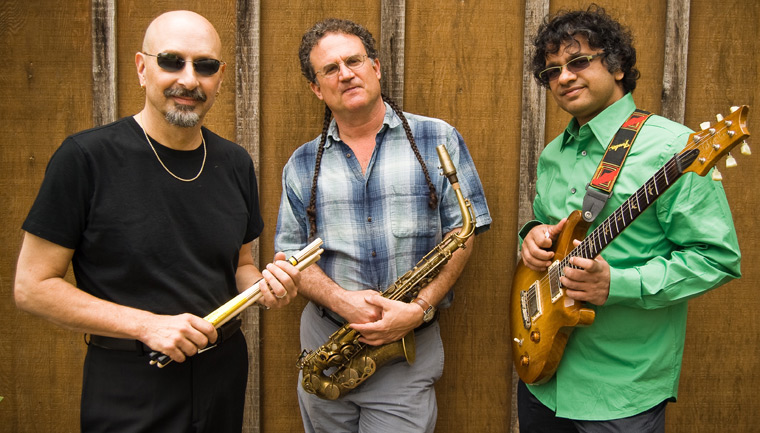Each week, World in Stereo examines classic and modern world music while striving for a greater appreciation of other cultures.
 Raga Bop Trio: s/t (Abstract Logix, 7/20/10)
Raga Bop Trio: s/t (Abstract Logix, 7/20/10)
Raga Bop Trio: “Tug of War”
[audio:https://alarm-magazine.com/wp-content/uploads/2010/10/Steve-Smith-George-Brooks-Prasanna-Tug-of-War.mp3|titles=TugofWar]Carnatic and Hindustani music, the classical music forms of North and South India, provide the base for the Raga Bop Trio. Saxophonist George Brooks is an established fixture in the Indian fusion scene as a devout student and purveyor of Hindustani music. He has collaborated with India’s most respected artists and his deep understanding of raga is a vital element to the trio’s melodic force. Guitarist Prasanna brings an avant-garde approach to the table by taking the ornamentations and tones found in South Indian Carnatic music and transferring them to the electric guitar. While he is able to mimic the subtle microtones of the sitar, he is also able to incorporate within them modern shape-shifting technology, demonstrated by his 2006 Carnatic/rock tribute to Jimi Hendrix, Electric Ganesha Land.
The rhythmic component of the trio is found in drummer Steve Smith, best known for his work with Journey. The virtuosic drummer, however, is a jack-of-all-trades type of player, providing the rhythmic foundation for jazz greats such Ahmad Jamal and Victor Wooten. While working with these two in 2002, Smith became fluent in the rhythmic underpinnings of Southern India.
Together, these three musicians put many different influences into play. Elements of rock, funk, and calypso find their way into a few tracks on the album. But ultimately, Raga Bop Trio is a thoroughly composed record that shows the effects of Indian music on jazz in full breadth.
John Coltrane was the first jazzman to truly fuse Indian music and jazz in dramatic fashion. Starting from Giant Steps and encompassing albums such as Impressions, Om, and Ascension, Coltrane’s stylistic transition is marked by the total abandonment of traditional harmonic structures. As he broke the Western harmonic boundary, his compositions integrated the elements of Indian music: rhythmic and metric variations, the sustain of the drone, and the use of one key which allowed movement between major and minor modes (much in the same way as raga).
The Raga Bop Trio is a descendent of this brand of jazz, finding new ways to push the East-meets-West dichotomy first made by Coltrane in the late 1950s. At the core of Indian classical music are two essential, interrelated basics: the raga, or melodic structure, and tala, or rhythmic cycle. Though the exclusion of the bass may be unusual in the Western jazz trio sense, the drums and saxophone/guitar duo adequately comprises a full sound.
Brooks and Prasanna strike a delicate balance in the melodic makeup of the music. On tracks like “Tug of War” and “Dubai Dance,” the saxophone and guitar meet in assaulting fashion, as the instruments are butted together, playing the same ascending and descending raga simultaneously. Prasanna is able to hit notes with a ferocity that only can be accomplished on guitar, but somehow has found the right configuration and technique to imitate a sitar. Surprisingly, with two high octave melodic echoes, Smith is able to give the tracks a full sound by accentuating the tom-toms, only using the snare to emphasize certain melodic phrases.
“Love and Hunger” proves the trio’s versatility, a track that begins in the East and slowly incorporates Western sounds to become a hybrid composition. Brooks lays down some rich alto saxophone lines over an Indian drone which takes form in Prasanna’s arpeggiated chords. But by the middle of the song it all begins to break down as Prasanna switches gears to play bass riffs on guitar and Brooks’ saxophone becomes attracted to the same modal phrase but with varied notes.
The album’s boldest track is “The Geometry of Rap,” a tune where Smith shows his Indian scat singing skills. Known as konnakol, it is the South Indian art form of performing percussion syllables vocally. Smith extends the track’s funk-induced drum beat by vocally soloing over it. Although the word “rap,” in the Western sense, gives the vocal performance all kinds of wrong connotations, it does add an unexpected dimension to the track.
The beauty of the Raga Bop Trio is that they are not exclusively North Indian or South Indian. Each musician’s passion for Indian music has played a huge role in creating a well-defined and controlled vision. By taking new approaches to an established musical structure, they have found a certain groove that is deeply rooted in classical Indian music while remaining within the Western harmonic.

